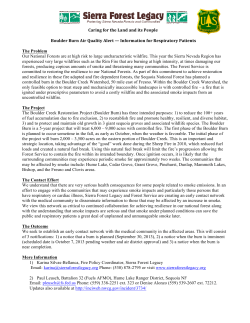
HARM TO KIDS FROM SECONDHAND SMOKE
HARM TO KIDS FROM SECONDHAND SMOKE On average, children are exposed to more secondhand smoke than nonsmoking adults. A study published in September 2010 found that more than 50 percent of children ages 3 through 11 had recent exposure to cigarette smoke during the study period (1999-2008). The primary source of secondhand smoke exposure for children is the home, but children are also exposed to secondhand 1 smoke in schools and other places, as well. That exposure increases the chances that the children will suffer from smoke-caused coughs and wheezing, bronchitis, pneumonia, potentially fatal lower respiratory 2 tract infections, eye and ear problems , and other problems including ADHD and other conduct 3 4 disorders. The respiratory health effects of secondhand smoke may even persist into adulthood. U.S. Surgeon General Statements on Children and Secondhand Smoke 5 • “Secondhand smoke contains more than 250 chemicals known to be toxic or carcinogenic (cancercausing), including formaldehyde, benzene, vinyl chloride, arsenic, ammonia, and hydrogen cyanide. Children who are exposed to secondhand smoke are inhaling many of the same cancer-causing substances and poisons as smokers.” • “Because their bodies are developing, infants and young children are especially vulnerable to the poisons in secondhand smoke.” • “Both babies whose mothers smoke while pregnant and babies who are exposed to secondhand smoke after birth are more likely to die from sudden infant death syndrome (SIDS) than babies who are not exposed to cigarette smoke.” • “Babies whose mothers smoke while pregnant or who are exposed to secondhand smoke after birth have weaker lungs than other babies, which increases the risk for many health problems.” • “Secondhand smoke exposure causes acute lower respiratory infections such as bronchitis and pneumonia in infants and young children.” • “Secondhand smoke exposure causes children who already have asthma to experience more frequent and severe attacks.” • “Secondhand smoke exposure causes respiratory symptoms, including cough, phlegm, wheeze, and breathlessness, among school-aged children.” • “Children exposed to secondhand smoke are at increased risk for ear infections and are more likely to need an operation to insert ear tubes for drainage.” • “The Surgeon General has concluded that the only way to fully protect yourself and your loved ones from the dangers of secondhand smoke is through 100% smoke-free environments.” • “If you are a smoker, the single best way to protect your family from secondhand smoke is to quit smoking. In the meantime, you can protect your family by making your home and vehicles smokefree and only smoking outside.” American Academy of Pediatrics’ on Children's Exposure to Tobacco Smoke 6 The American Academy of Pediatrics has made the following conclusions regarding exposure of children to secondhand smoke: • “Results of epidemiologic studies provide evidence that exposure of children to environmental tobacco smoke is associated with increased rates of lower respiratory illness and increased rates of middle ear effusion, asthma, and sudden infant death syndrome.” • “Exposure during childhood to environmental tobacco smoke may also be associated with development of cancer during adulthood.” 1400 I Street NW · Suite 1200 · Washington, DC 20005 Phone (202) 296-5469 · Fax (202) 296-5427 · www.tobaccofreekids.org Harm to Kids from Secondhand Smoke / 2 The American Academy of Pediatrics recently adopted a resolution encouraging all its member state and local societies and chapters to: “support and advocate for changes in existing state and local laws and policies that protect children from secondhand smoke exposure by prohibiting smoking in any vehicle while a legal minor (under 18 years of 7 age) is in the vehicle.” Campaign for Tobacco-Free Kids, October 4, 2012 For more on secondhand smoke, see the Campaign website at http://www.tobaccofreekids.org/facts_issues/fact_sheets/toll/products/secondhand_smoke/ 1 U.S. Centers for Disease Control and Prevention (CDC), “Nonsmokers’ Exposure to Secondhand Smoke in the United States, 1999-2008,” Morbidity and Mortality Weekly Report (MMWR) 59(35), September 10, 2010. http://www.cdc.gov/mmwr/pdf/wk/mm5935.pdf. 2 The Health Consequences of Involuntary Exposure to Tobacco Smoke: A Report of the Surgeon General, U.S. Department of Health and Human Services, Children are Hurt by Secondhand Smoke, http://www.surgeongeneral.gov/library/secondhandsmoke/factsheets/factsheet2.html; The Health Consequences of Involuntary Exposure to Tobacco Smoke: A Report of the Surgeon General, U.S. Department of Health and Human Services, How to Protect Yourself and Your Loved Ones from Secondhand Smoke http://www.surgeongeneral.gov/library/secondhandsmoke/factsheets/factsheet3.html. 3 Bandiera, Frank C. et al., “Secondhand Smoke Exposure and Mental Health Among Children and Adolescents,” Archives of Pediatric and Adolescent Medicine (165) 4: 332–338, 2011. 4 Pugmire, J., et al., “Respiratory Health Effects of Childhood Exposure To Environmental Tobacco Smoke in Children Followed to Adulthood,” American Journal of Respiratory and Critical Care Medicine (186)1: 1758, 2012. 5 The Health Consequences of Involuntary Exposure to Tobacco Smoke: A Report of the Surgeon General, U.S. Department of Health and Human Services, Children are Hurt by Secondhand Smoke, http://www.surgeongeneral.gov/library/secondhandsmoke/factsheets/factsheet2.html; The Health Consequences of Involuntary Exposure to Tobacco Smoke: A Report of the Surgeon General, U.S. Department of Health and Human Services, How to Protect Yourself and Your Loved Ones from Secondhand Smoke http://www.surgeongeneral.gov/library/secondhandsmoke/factsheets/factsheet3.html. 6 American Academy of Pediatrics, Committee on Environmental Health, “Environmental Tobacco Smoke: A Hazard to Children”, Pediatrics, Vol. 99, No. 4, April 1997. 7 American Academy of Pediatrics, Resolution on Secondhand Smoke Exposure of Children in Vehicles (Resolution # LR2, (06) – 2006/2007 Annual Leadership Forum).
© Copyright 2025





















